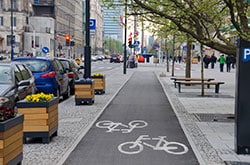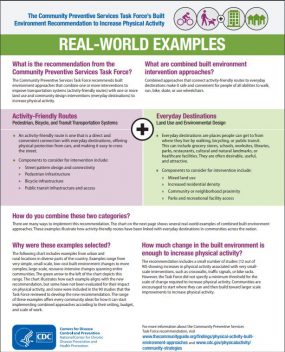Designing Activity-Friendly Communities
Learn how improving walkability provides many opportunities for people to be physically active.

Activity-friendly communities encourage physical activity.
Walking is an excellent way to help people become more active and improve their health. It is an easy way to begin and maintain a physically active lifestyle, and it is the most common form of physical activity for people across the country. People walk for many purposes, such as for transportation to get to school or work, for leisure to have fun, or to improve their health.
Ultimately, individuals make the decision to walk. However, the decision to walk can be made easier by improving and connecting routes and destinations in communities. Modifying the built environment makes it easier for people of all ages and abilities to walk, bike, run, or roll. For example, community design can locate residences within short walking distance of stores and public transportation. Sidewalks or paths between destinations can be designed and maintained to be well-connected, safe, and attractive. Transportation and travel policies that create or enhance pedestrian and bicycle networks or expand public transportation systems can be another approach to encourage active transportation, such as walking or biking. Improving walkability of communities can also help people who participate in other types of physical activities, such as those who bike or use wheelchairs.
Connecting Routes + Destinations to Increase Physical Activity Download [PDF-163KB]
Creating or modifying environments to make it easier for people to walk or bike is a strategy that not only helps increase physical activity, but it can also make communities better places to live. Studies show more people bike and walk in communities where improvements have been made, such as adding safer sidewalks, pedestrian crossings, and protected bike lanes. In addition, when people move to neighborhoods that are designed to promote physical activity and active transportation, they tend to spend less time in their cars and more time walking for transportation. Making walking easier can also help communities by improving safety, increasing interaction between residents, improving local economies, and reducing air pollution.
To make more communities walkable and help more people walk enough to reap health benefits, Active People, Health Nation, an initiative led by the Centers for Disease Control and Prevention, is working with state and community-based organizations to get 27 million Americans more physically active. The initiative aims to create opportunities for active transportation and leisure time physical activity by:
- Promoting social support interventions such as walking groups that strengthen social networks to help people increase their physical activity.
- Enhancing or creating pedestrian master plans to make walking a safer, more convenient, and more realistic travel option.
- Adopting Complete Streets policies for safe and convenient access to community destinations.
- Participating in Safe Routes to Schools programs to create safe, convenient, and fun opportunities for children to bicycle or walk to and from school.
Combined Approaches to Increase Physical Activity
Activity-Friendly Routes
A direct and convenient connection with everyday destinations, offering physical protection from cars, and making it easy to cross the street.

Everyday Destinations
Places people can get to from where they live by walking, bicycling, or public transit, i.e. grocery stores, schools, worksites, parks, restaurants, etc.
- STEP IT UP! The Surgeon General’s Call to Action to Promote Walking and Walkable Communities
- Combined Built Environment Features Help Communities Get Active
- Status Report of the Call to Action[PDF-1.24 MB]
- Physical Activity Guidelines, 2nd edition [PDF-14.5MB]
- Health Benefits of Physical Activity
- The Community Guide
- CDC’s Designing and Building Healthy Places

